ATCommands
Manual Answering
For reasons of data security, it may be desirable to verbally identify a caller before allowing connection to your computer. A telephone handset must be connected to the same telephone line as your modem to permit manual answering.
•Place front panel Option switch 4 in the Up position (select Smart mode)
•Connect your modem to a personal computer — refer to the modem Read Me First Guide for details
•Run a communications program and enter “local mode” or “terminal mode”
•Type: ATBx <E>
where “x” is a valid setting of the B command. The B command is used to set the communications standard used by your modem.
•Type: AT&D2&M0 <E> or:
Type: AT&D2&M1 <E>
Issue the &M0 command if you wish to use asynchronous communications; issue &M1 if you wish to use synchronous communications.
•Type: AT&W <E>
The modem set up is saved.
•Place front panel Option switch 4 in the Down position (select Dumb mode)
•Place front panel Option switch 6 in the Up position (select Answer mode)
•Place front panel Option switch 3 in the Down position (stop autoanswering of incoming calls)
If the &D2 command has been issued to your modem, your computer must raise the DTR signal
•Press the Talk/Data button to Talk (this button is located next to the front panel Option switches)
•When the telephone handset rings, pick it up and establish the caller identity
The person calling you must perform a manual dial (that is, he/she must dial using a telephone handset).
•When you are ready to allow access to your computer, press the Talk/ Data button to Data
•Place the handset
At the same time, the caller must make his/her modem enter “data mode” and place his/her handset
The OH and CD LEDs glow when the modems connect.
Page 61
